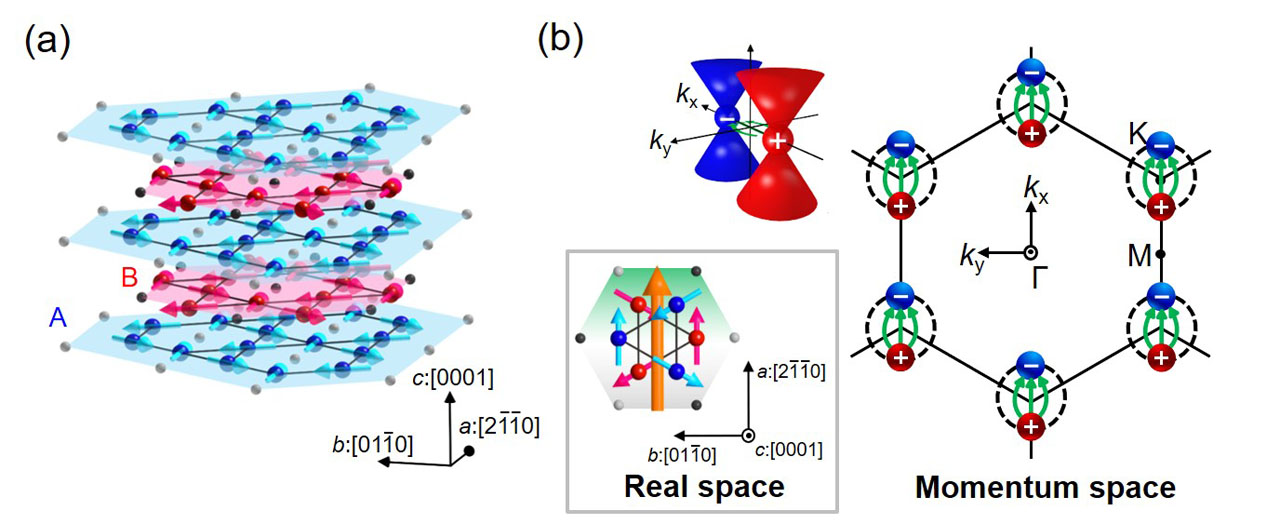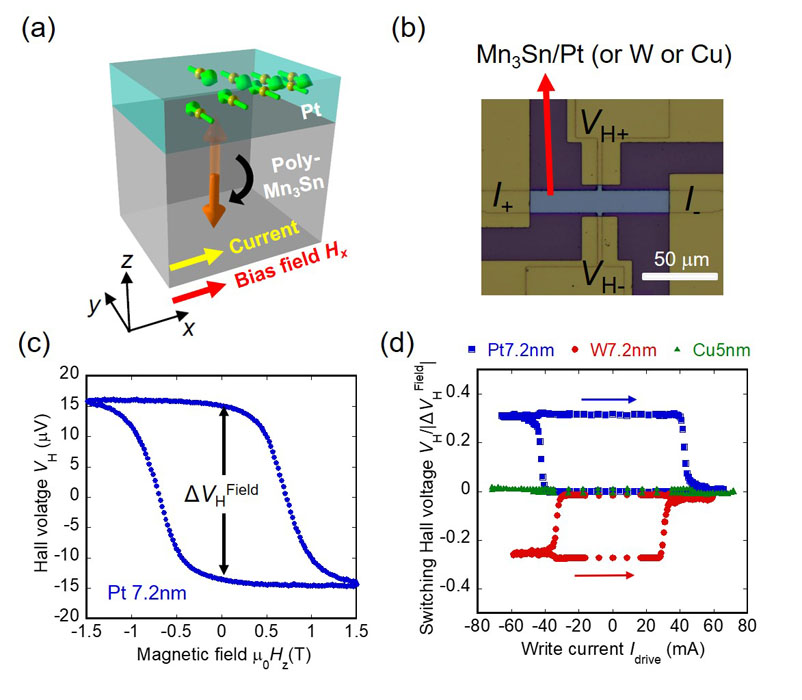Electrical Manipulation of a Topological Antiferromagnetic State
Nakatsuji, Otani, and Miwa Groups
The Weyl semimetal features nodal points formed by two linearly dispersive non-degenerate bands. These touching points or Weyl nodes act as topologically protected monopoles or antimonopoles of underlying Berry curvature, resulting in large anomalous Hall effect (AHE) and chiral anomaly. The electrical manipulation of Weyl nodes is among the key topics of technological innovation utilizing a novel topological state. Moreover, electrical manipulation of an antiferromagnetic Weyl metal is considered a significant advancement, given the prospects of antiferromagnetic (AF) spintronics for realizing high-density, ultrafast devices [1].
We demonstrate the electrical switching of the AF Weyl state using Mn3Sn/nonmagnetic metals (NM = Pt, W, Cu) bilayer devices and the spin-orbit torque (SOT) switching method [5]. The inverse triangular spin structure of Mn3Sn can be viewed as a ferroic ordering of cluster magnetic octupoles. The magnetic octupole’s polarization direction determines the location of Weyl nodes and the associated distribution of the Berry curvature in the momentum space (Fig. 1(b) right) [2]. With an electrical current applied to the Pt layer, a spin polarized current generated by the spin Hall effect of Pt induces the SOT on the Mn3Sn layer and causes the switching of the polarization direction of the magnetic octupole (Fig. 2a). The measurement configuration and optical micrograph of the fabricated bilayer Hall bar devices are shown in Fig. 2(b). We first perform the magnetic field switching of the Hall voltage VH by using an out-of-plane magnetic field Hz and a read current of 0.2 mA, and a clear hysteresis of VH with the zero-field change of ΔVHfield (= VH(+Hz→0) − VH(−Hz→0)) is observed (Fig. 2(c)). To examine the possible SOT switching of Mn3Sn, we pass a 100 ms write-pulse current Iwrite along the x-direction; then, we wait for 600 ms after the pulse current and measure VH with a 0.2 mA read current. Figure 2(d) shows VH as a function of Iwrite in Pt, W, and Cu devices. For the NM = Pt (spin Hall angle θSH > 0) and a bias field Hx parallel to the current direction, a clear negative (positive) jump appeared in the Hall voltage for a positive (negative) current larger than a critical threshold write-current Ic. The magnitude of the jump reaches ~30 % of the total Hall voltage change |ΔVHfield | in the field sweep measurements. To confirm that the observed switching of VH is related to the SOT due to the spin Hall effect in the NM layer, we prepared NM = W (θSH < 0) and Cu (θSH ~ 0). For NM = W, the switching polarity is opposite to the Pt case, while for NM = Cu, hysteresis is absent with the electrical current cycle. The difference in switching polarity between Pt and W devices and the absences of switching in Cu devices cannot be explained by the current-induced Oersted field but agree well with the sign of θSH of the NM layer. These results demonstrate that SOT from the NM layer induces the perpendicular switching of the AF domain and thus manipulates the direction of the Weyl nodes.

Fig. 1. (a) Mn3Sn crystal structure and inverse triangular spin (ITS) structure. The Mn magnetic moments (light blue and pink cylindrical arrows) lie within the kagome layer with the ABAB stacking sequence and form the ITS structure at room temperature. This spin structure can be viewed as a ferroic ordering of cluster magnetic octupoles. (b) Bottom-left: cluster magnetic octupole (orange cylindrical arrow) consisting of the six spins on the kagome bilayer. Right: schematic of the Weyl point distribution near the Fermi energy in momentum space (kx-ky plane at kz = 0); the corresponding magnetic structure is shown in the left-side figure. The red and blue spheres correspond to Weyl nodes acting as sources (+) and drains (-) of the Berry curvature (green arrows). Inset: three-dimensional schematic of a pair of Weyl nodes.

Fig. 2. (a) Schematic image for the spin-orbit torque switching. Under a write current and a bias field along the x-direction, the spin-polarized current in Pt (green cylindrical arrows on yellow spheres) exerts a spin-orbit torque, causing the polarization axis of the cluster magnetic octupole to switch (orange cylindrical arrow) in the polycrystalline Mn3Sn (b) Measurement configuration and optical micrograph of the Mn3Sn-nonmagnet bilayer Hall bar devices. (c) Hall voltage VH vs. magnetic field along the z-direction Hz obtained for the Mn3Sn/Pt 7.2 nm device at room temperature. (d) Hall voltage VH vs. write current Iwrite for the Pt 7.2 nm, Cu 5 nm, and W 7.2 nm devices at room temperature. The Hall voltage is normalized by the zero-field Hall voltage |ΔVHfield| obtained from the magnetic field dependence measurements for each sample.
In recent years, utilizing antiferromagnets in spintronics devices have attracted significant attention as its vanishing small stray fields and much faster spin dynamics than ferromagnets [1]. We achieved the electrical switching of the AF Weyl metal using the same protocol as the one used for ferromagnetic metals [3, 4]. The critical write current density in the NM layer is considerably smaller than that in the NM/FM devices. These results indicate that topological antiferromagnets offer the unmatched potential for spintronic applications that may surpass today’s ferromagnetic counterparts [5].
References
- [1] T. Jungwirth et al., Nat. Nanotechnol. 11, 231 (2016).
- [2] S. Nakatsuji, N. Kiyohara, and T. Higo. Nature 527, 212 (2015).
- [3] I. M. Miron et al., Nature 476, 189 (2011).
- [4] L. Liu et al. Science 336, 555 (2012).
- [5] H. Tsai, T. Higo, K. Kondou, T. Nomoto, A. Sakai, A. Kobayashi, T. Nakano, K. Yakushiji, R. Arita, S. Miwa, Y. Otani, and S. Nakatsuji, Nature 580, 608 (2020).
